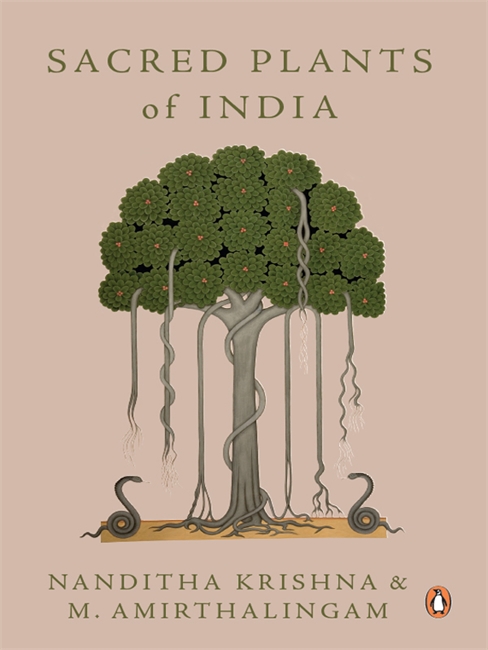
© 2020 Penguin India

Plants personify the divine— The Rig Veda (X.97)
Trees and plants have long been held sacred to communities the world over. In India, we have a whole variety of flora that feature in our myths, our epics, our rituals, our worship and our daily life. There is the pipal, under which the Buddha meditated on the path to enlightenment; the banyan, in whose branches hide spirits; the ashoka, in a grove of which Sita sheltered when she was Ravana’s prisoner; the tulsi, without which no Hindu house is considered complete; the bilva, with whose leaves it is possible to inadvertently worship Shiva. Before temples were constructed, trees were open-air shrines sheltering the deity, and many were symbolic of the Buddha himself.
Sacred Plants of India systematically lays out the sociocultural roots of the various plants found in the Indian subcontinent, while also asserting their ecological importance to our survival. Informative, thought-provoking and meticulously researched, this book draws on mythology and botany and the ancient religious traditions of India to assemble a detailed and fascinating account of India’s flora.
Imprint: India Penguin
Published: May/2014
ISBN: 9780143066262
Length : 312 Pages
MRP : ₹399.00
Imprint: Penguin Audio
Published:
ISBN:
Imprint: India Penguin
Published: May/2014
ISBN: 9789351186915
Length : 312 Pages
MRP : ₹399.00
Plants personify the divine— The Rig Veda (X.97)
Trees and plants have long been held sacred to communities the world over. In India, we have a whole variety of flora that feature in our myths, our epics, our rituals, our worship and our daily life. There is the pipal, under which the Buddha meditated on the path to enlightenment; the banyan, in whose branches hide spirits; the ashoka, in a grove of which Sita sheltered when she was Ravana’s prisoner; the tulsi, without which no Hindu house is considered complete; the bilva, with whose leaves it is possible to inadvertently worship Shiva. Before temples were constructed, trees were open-air shrines sheltering the deity, and many were symbolic of the Buddha himself.
Sacred Plants of India systematically lays out the sociocultural roots of the various plants found in the Indian subcontinent, while also asserting their ecological importance to our survival. Informative, thought-provoking and meticulously researched, this book draws on mythology and botany and the ancient religious traditions of India to assemble a detailed and fascinating account of India’s flora.
M. Amirthalingam is a botanist and environmental education officer at C.P.R. Environmental Education Centre, Chennai. He has researched and published the books Sacred Groves of Tamil Nadu, Sacred Trees of Tamil Nadu, Temple Tanks of Chennai, and Flora and Fauna of Valmiki’s Ramayana, besides research papers and articles in various journals, magazines, and seminar proceedings. He is currently working on the All India Coordinated Research Project on Sacred Grove Ecosystem Service Assessment in the Inland Plains of Tamil Nadu sponsored by the ministry of environment and forests, Government of India.
A historian, environmentalist and writer based in Chennai, Nanditha Krishna has a PhD in ancient Indian culture from the University of Bombay. She has been a professor and research guide for the PhD programme of C.P.R. Institute of Indological Research, affiliated to the University of Madras. She was the honorary director of the C.P. Ramaswami Aiyar Foundation from 1981 and was elected president in 2013. She is the founder-director of its constituents, including C.P.R. Institute of Indological Research, C.P.R. Environmental Education Centre, C.P. Art Centre and Kanchi Museum of Folk Art. She is the author of several books, including Sacred Plants of India, Sacred Animals of India, Hinduism and Nature, Book of Demons and Book of Vishnu (Penguin India); Madras Then, Chennai Now, Balaji Venkateshwara, Ganesha, Painted Manuscripts of the Sarasvati Mahal Library; and The Arts and Crafts of Tamilnadu and The Art and Iconography of Vishnu-Narayana, among many others, besides numerous research papers and newspaper articles.